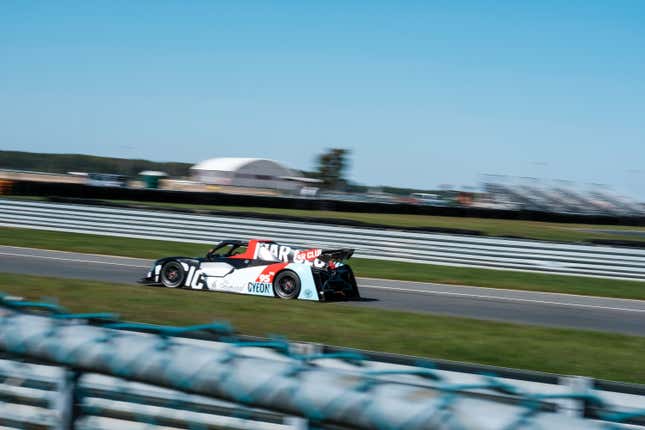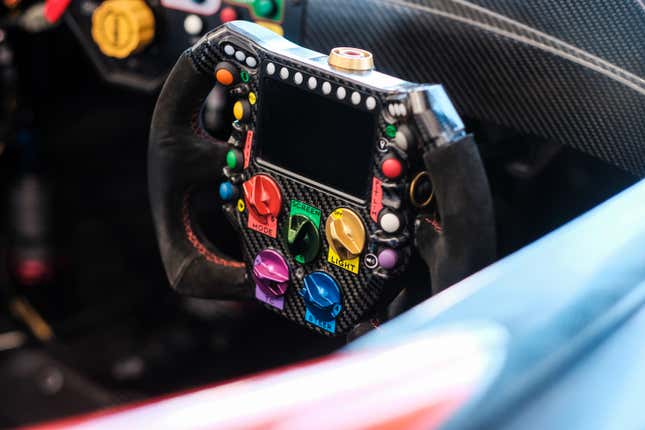Sports cars like the Corvette Z06 have become formidable all-purpose tools, segueing easily from street to track. Yet no matter how good street-legal cars get, they remain the all-season tire of track performance: A compromise in both directions, hamstrung by excess weight, creature comforts and safety and emissions regulations. That realization leads some serious drivers — including amateur racers with big dreams and bigger budgets — to dedicated track cars like the Revolution A-One.
I drive a lot of street cars on track — the greatest perk of this job — and the Revolution gave me a 500-horsepower, 1,870-pound attitude adjustment. It’s a reminder of what fast driving is supposed to feel like: Raw and unfiltered, just you, a quivering steering wheel and whatever speed you can coax from the chassis and brakes. A racing kart times 10, just a few ticks shy of a LeMans prototype, yet less intimidating for the ambitious amateur.

The A-One is the natural next step for Phil Abbott, the esteemed engineer and now-departed co-founder of Radical. In place of the last Radical’s tube frame, the A-One gets a carbon-fiber monocoque, constructed using a McLaren-esque resin transfer molding (RFM) process that saves time, money and energy, and earns full FIA safety approval. Extensive computational fluid dynamics work coaxes massive, yet predictable downforce from this bewinged beast. At 110 mph, the A-One develops more than 1,500 pounds of downforce; for context, the 2023 Porsche 911 GT3 RS, which looks ridiculous in the name of downforce, only generates 900 pounds at 124 mph — still far and away the highest amount of aerodynamic grip generated by a street-legal production car, more than three times what you get from a standard GT3.
Next, Abbott and his son James — a company engineer and lead development driver who was on hand during our drive event — transform a prosaic, 3.7-liter Ford Cyclone V-6 crate engine. They slice three inches off the bottom, installing a dry-sump oiling system to mount the engine as low as possible in the chassis. They add individual throttle bodies, high compression pistons, and new cams, all good for 427 horsepower in the $193,000 A-One.

That still wasn’t enough for some North American tastes, so the Abbotts strapped on a gear-driven centrifugal supercharger in the 500-hp version I’m driving at New Jersey Motorsports Park. All that pavement-sucking force, feathery curb weight and open-cockpit sensation make the Revolution an all-day endorphin dispenser, but also an ideal training tool for track-day lovers or competitors in sports prototype series.
I clamber over the A-One’s carbon-fiber body and F1-style halo fairing — which proved its mettle recently when one airborne Revolution landed on top of another during an F1 support race in Monza; both drivers walked away unscathed. As my HANS device and arm restraints are attached, I meet a surprisingly roomy two-person cockpit, ideal for an owner and a driving coach (or the friend you’d like to terrify). A cut-down, removable steering wheel avoids the overwhelming profusion of switches seen in Formula 1, sticking with what’s necessary, including a pit lane speed limiter and simple screen readouts. There’s a clutch pedal just to get rolling from a stop; from there it’s as simple as driving a Mercedes, clicking through a six-speed paddle-shift transmission from France’s 3MO, known for World Rally Car gearboxes.

A sturdy Tilton pedal box is well situated for left-foot braking. The driving position is relatively upright, unlike the half-prone Pilates stretch of some race cars. It all makes for an easier acclimation period. I’m soon wailing around the Thunderbolt circuit, the A-One’s supercharged V6 shriek pummeling my noggin at 108 decibels. (For my next stint, I make sure to stuff in earplugs.) The downforce-aided brakes are heroic, recalibrating my street-based notions of braking points. Abbott pulls some onboard data from the car and shows me that I could be mashing the pedal even harder to shave lap time.
A double wishbone suspension with inboard-mounted dampers features an adjustable third element for easy tuning on individual circuits. Multi-setting traction control on the steering wheel helps drivers steadily build speed as they gain experience. Oversteer is definitely lurking for the driver who misjudges inputs (or their own skill level), yet the Revolution feels so balanced and trustworthy that drivers can focus on the stuff that matters — the racing line, vision, smooth entries and exits — without worrying that the car is going to kill them.

And the A-One’s bandwidth of accessible performance, combined with leading-edge safety, may be its biggest lure for prospective buyers, including team owners and drivers in sports-prototype series around the world. The heights are certainly tantalizing: At tracks including Monza and Portimao, top Revolution pilots are putting up lap times just 1 or 1.5 seconds behind full LMP3 cars. That’s heady stuff for a car that costs around $218,000 in 500-hp trim, including the carbon-fiber halo, extra wheels and other mechanical spares, lightweight bodywork and uprated dampers. Since any driver not named Verstappen has to keep an eye on their track budget, the A-One also strives for low running costs: It can run 93-octane pump gas, versus the $12-a-gallon racing stuff, and romp on track for about 6,200 miles or 100 hours before any major servicing is needed.
Now, 200 grand may sound like a lot for a car that’s hard to brag about — “er, what’s a Revolution?” – and impossible to show off at your Cars and Coffee unless you bring it on a trailer. (Then again, anybody who can afford a Revolution and all the cost of competing with it probably has a nice Porsche or Ferrari to bring to Sunday meetups.) But serious track rats see the wisdom of choosing the right tool for the right job. And the first time that Corvette Z06 driver shows up at a track day, they better give the Revolution a point-by, or things are gonna get embarrassing.